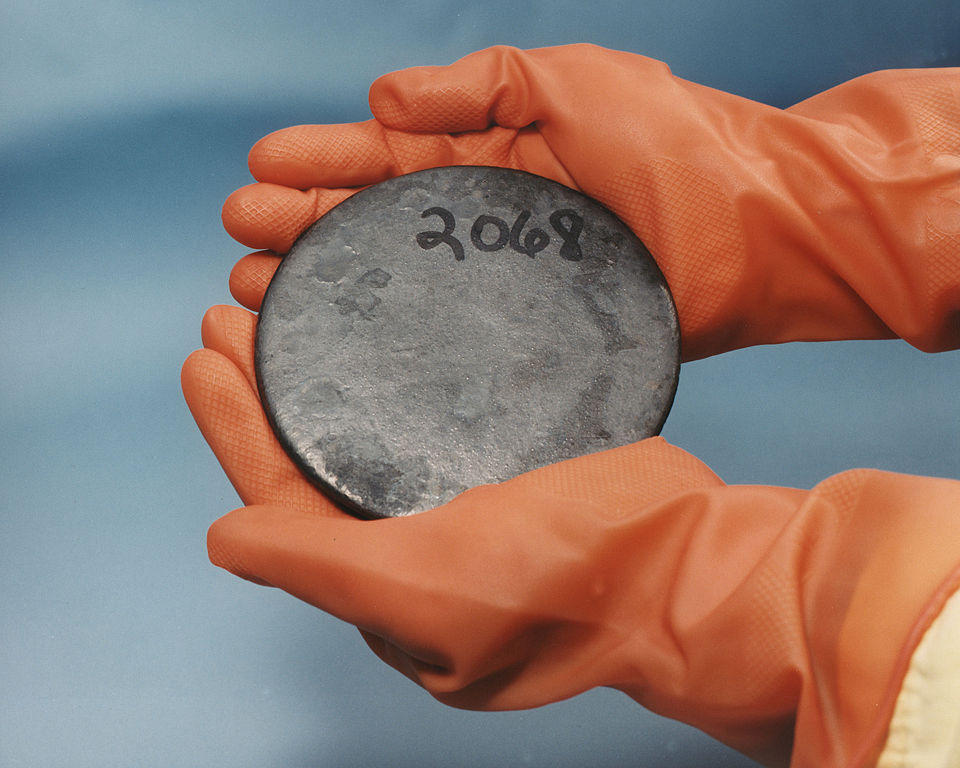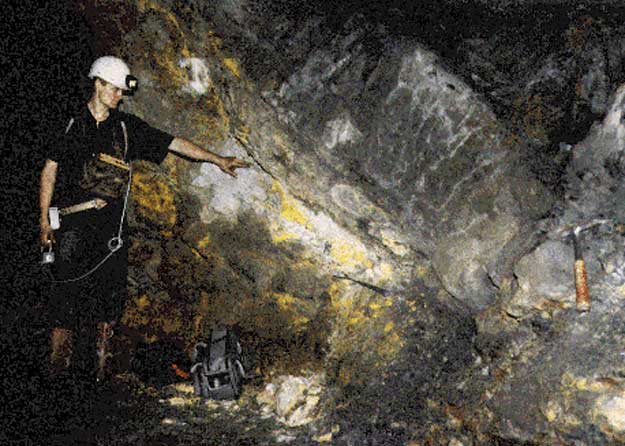The nuclear age might have begun in America, but it was in Gabon where the world’s first fission reaction started.
Gabon is one of the richest country in Sub-Saharan Africa, with a per capita income four times that of its neighbors. Its economy is dominated by oil, followed by timber and manganese exports. For a brief period, Gabon also exported uranium, the precious raw material used in nuclear power plants and nuclear weapons. The mines have dried up today, but nearly two billion years ago there was enough uranium here to cause the rocks to undergo spontaneous nuclear fission.

A billet of highly enriched uranium-235. Photo credit: United States Department of Energy
Uranium occurs in nature in the form of three isotopes, or variants that differ from each other by the number of neutrons in its nucleus. The most common form is uranium-238, which accounts for 99 percent of all uranium on earth. About 0.72 percent is uranium-235 and a very small amount, about 0.006 percent, is uranium-234. All the three isotopes of uranium are unstable, and are weakly radioactive, but only uranium-238 and uranium-235 can undergo nuclear fission. Between this two, uranium-238 is more stable, while uranium-235 undergoes fission more readily, and is therefore the most common fuel used in nuclear power reactors.
The three uranium isotopes are distributed in the earth’s crust with remarkable uniformity, so that any uranium ore mined today will contain exactly 0.72 percent of uranium-235. However, this concentration is too low to induce nuclear fission. The uranium needs to be enriched first through a complicated process involving centrifuges and gaseous diffusion so that its concentration becomes at least 3 percent. A typical nuclear reactor requires between 3 to 5 percent uranium-235, and a nuclear bomb requires a whopping 90 percent.

Nuclear fission of uranium-235
The proportion of uranium-235 relative to uranium-238 in an ore has been changing since the earth formed because uranium is radioactive and decays to other elements over time. Uranium-238 decays at a much slower rate (it has a half-life of 4.5 billion years) than uranium-235 (half-life of 700 million years), so uranium-235 was available at a much high concentration eons ago than it is today. Since we know the half-life of uranium-235, we can easily estimate how much of it was available at different geological times. For example, 700 million years ago there was twice as much uranium-235 as it is today (1.3 percent), and four times as much 1.4 million years ago (2.3 percent). Remember, that as we go back in time the amount of uranium-238 is also increasing, albeit at a slower rate, so percentages don’t double. The concentration of uranium-235 was nearly 4 percent two billion years ago, and 17 percent at the time of formation of the solar system.
In the 1950s, scientists hypothesized that with so much uranium-235 concentrated on the earth’s crust millions of years ago, some of that must have undergone fission naturally provided the conditions were just right. In 1956, Japanese-American physicist Paul Kuroda compounded on the idea and theorized the conditions under which nuclear fission could spontaneously develop and be sustained. Kuroda suggested that for nuclear fission to start naturally the site must have a high uranium content and the thickness of the ore must exceed the average length that fission-inducing neutrons travel, about two thirds of a meter. There must also be a moderator, something that can slow down the neutrons produced when uranium fissions. And finally, there must not be significant amounts of neutron-absorbing elements (such as silver or boron), which would inhibit a self-sustaining nuclear reaction.
Such a natural reactor was discovered sixteen years later, in 1972, in Gabon. At that time the French had been mining uranium in Gabon—a former French colony—for use in nuclear power plants. During a routine measurement of uranium ore from a mine in Oklo, in southeastern Gabon, the French noticed that the uranium-235 content in the ore was not 0.72 percent, but less. (There appears to be some disagreement on how less the figures were. According to some publications, the ores mined at Oklo had a uranium-235 concentration of 0.717 percent—a difference of only 0.003 percent. But as per others, the difference was significant. According to a paper published in “International Journal of Modern Physics”, the ores from Oklo had only 0.60 percent uranium-235.)
Further examination revealed trace amounts of other elements embedded in the ore, whose percentage strongly resembled those found in spent fuel generated by nuclear power plants. These findings suggested only one thing—the mine in Oklo from where uranium was obtained had underwent spontaneous nuclear fission at some point in the distant past. The uranium-235 in the ore was depleted because some of that uranium had been used up in the fission.

A natural nuclear reactor in Oklo, Gabon. Uranium oxide remains are visible as the yellowish rock. Photo credit: Robert D. Loss/APOD
After this astonishing discovery, physicists began probing the uranium mines in Oklo for more evidences and eventually discovered at least sixteen sites within this region where spontaneous nuclear fission had taken place.
Over the next several years, researchers were able to work out the details of how these prehistoric reactors might have operated. About 2.4 billion years ago, due to the biological activity of cyanobacteria, the oxygen content in the atmosphere of earth increased a hundred fold. This allowed uranium to be converted from its insoluble form to its soluble oxide. Water from rainfall and natural sources dissolved the uranium and deposited them in sandstone layers until they became well-concentrated to start a chain reaction. The water in the mine itself played a critical role in sustaining the reaction. The water slowed the ejected neutrons so that they could be absorbed by other nuclei and trigger fission. Without the water, the neutrons would have simply bounced off the atoms. When the heat from the nuclear fission became too great, it boiled all the water away and the reaction stopped. Once the water returned the process started again. These periods of activity and inactivity were probably very short. The math suggest the reactors switched “on” for 30 minutes and “off” for about 3 hours.
The Gabon reactors functioned intermittently this way for probably a million years or more until uranium concentration became too low to keep the reactions going. From the amount of uranium-235 consumed in the reactors, scientists estimate that average power output of the reactors were probably less than 100 kilowatts.
Thanks to the relative stability of the African craton, these ancient natural reactors have moved very little from their original positions. In one case, plutonium, one of the byproducts of the reaction, was found less than 10 feet away from where it formed two billion years ago. Perhaps natural nuclear reactors operated in several other places on Earth billions of years ago, but has since been eroded away or swallowed by the earth’s crust. The Gabon natural nuclear reactors remain truly unique.



Comments
Post a Comment